
|
|
11 June, 2002
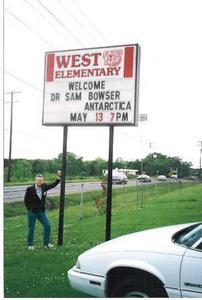
Dr. Bowser came to visit my students in Mt. Juliet, Tennessee, on May 13, 2001 (three months after his return from Antarctica). He spent all day at our school beginning with a two-hour (non-stop) question/answer session with my students. I think the biggest change that I noticed with my students from this Antarctic experience was how their questions changed over time. At the beginning of the year, the students asked the typical questions: "How cold will it be in Antarctica?" and "Will you see penguins?" By the time Dr. Bowser visited in May, the students were asking questions specific to Dr. Bowser's research. (Dr. Bowser has gone to Antarctica nine times to do research on the Astrammina rara , which are one-celled organisms (protists) called foraminifera (forams). The students' many questions amazed me because during the course of the year, the questions were more centered and sophisticated: "Does the Astrammina rara's glue only stick under water?" "Does the pseudopods come out to catch a specific thing or does it just go out like a web?" "How can the forams survive in the cold water without blubber?" "What is the pseudopod's web made of?" "Why do one-celled organisms survive in Antarctica, but humans can't?" "Do any forams live in soil instead of water?" "Do forams kill their food before they eat it, and if so, how do they do it?" Who would have thought that nine and ten year olds could identify and use terminology pertaining to this project? As the "story" began to unfold, and as the students began to experience this project through this Antarctic experience, they began to personalize the Astrammina rara and Dr. Bowser. They felt he was "their" scientist, and for the first time, they came to know that scientists are real people. I don't know if one of the students will eventually become a scientist, but I feel that they will never see science in the same way again. This Antarctic project made the students see that science was real and very much a part of their lives. Science should not be seen as a "subject" we learn in school, but rather as a valuable part of our education. In our lifetime, we will all be affected by science. Dr. Bowser and his research, along with the other scientists on my team, definitely made an impact on my students.

During this visit, Dr. Bowser also took time to show my students "life under the microscope". One of my students commented that he couldn't believe there was a whole new world he never knew existed. Dr. Bowser spoke to 831 people in a 24- hour period, including students (grades K-7), members of the Wilson County Board of Education, supervisors, teachers, the parent/teacher organization, members of the Mt. Juliet community, and the Mt. Juliet Rotary Club. His presentation and slides brought the reality of this wonderful Antarctic project into my community. This project and Dr. Bowser, along with my other team members, have made an impact on my teaching. I felt fortunate that Dr. Bowser could come share this experience with the many people in my community who supported the project from home.

Dr. Bowser helped me realize that the Earth is not fragile; we are. Working in Antarctica with scientists gave me the opportunity to see how important it is for the general public to understand science in order to make informative decisions about our environment and life on Earth. I asked Dr. Bowser to write the following summary of this project's activities, which occurred after I left Antarctica. (Dr. Bowser's team continued research in Antarctica during January/February, 2002.) The photos and text were sent to me from Dr. Bowser to share with you. Note from Dr. Sam Bowser, principal investigator:
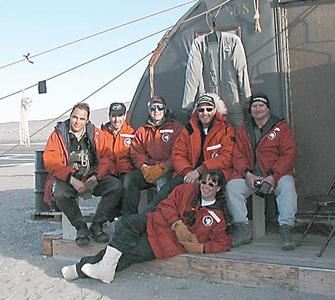
Note from Dr. Sam Bowser, principal investigator: I returned to Explorers Cove in January, with Dr. Joan Bernhard replacing Jan Pawlowski, Gogi Gwardschaladse replacing Neal Pollock, and Dr. Steve Hanes replacing Phil Forte. I was surprised by the incredible weather in January: hot (50 degrees F!) and sunny, with no wind to speak of. The 24/7 sun baked the ground, and walking barefoot on the sandy beach was an interesting experience.
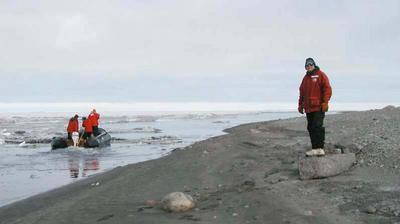
The sea ice was still 11 ft thick, but the freshwater ice along the shoreline had melted by mid-December, forming an ice water moat up to 60 ft wide and 30 ft deep. We had to cross this moat in a small boat -- a Zodiac to be exact -- which was equipped with an outboard motor.
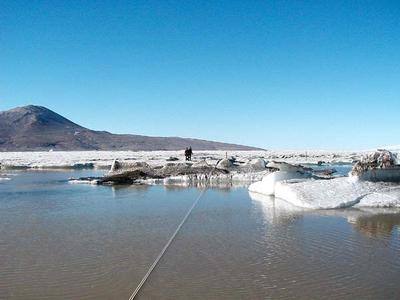
We first tried to pull the boat by hand, using a long rope strung across the moat. Unfortunately, chunks of moat ice shaped like miniature icebergs hung up on the rope and blocked our way.

The motor proved invaluable, because it allowed us to scoot around any obstruction. Once on the sea ice, we continued working as before: scuba diving to collect foraminifera, and dropping the CTD device to collect information about the water column. This wasn't as "easy" as it was in October, since each hole was surrounded by quite a bit of meltwater.
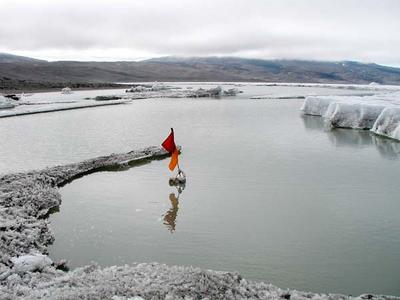
The divers noted that the water was getting murky, at least by Explorers Cove standards. Visibility had dropped to about 100 feet, and blobs of "ice algae" were raining down from the underside of the ice and carpeting the seafloor. I wish I could have seen these changes first hand, but I was having some health problems and couldn't dive. We still do not know how the foraminifera respond to these changes, but we are working on this question.
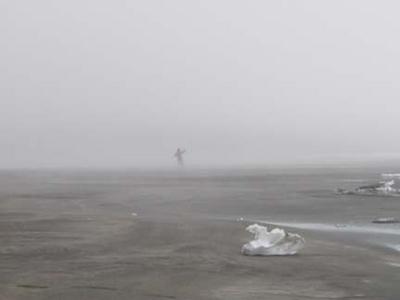
Toward the end of January, the situation changed dramatically. The hot sunny days switched to cold, clammy ones, with lots of fog sweeping in from the Sound. This was unfortunate. While we were rushing to collect our last samples, and pack everything up for our return to McMurdo, there was a bad storm. In fact, it rained! I never knew it to rain at the base of the "Dry Valley" but our soaked parkas were proof. We had already placed many of our supplies and much of the equipment into neat piles outside, and everything was getting drenched. After about an hour the rain switched to wet snow and this snow turned the lovely beach into slogging ground. We new our neat stacks would turn into frozen blocks as it got even colder, but there wasn't much we could do about it. We moved the science gear into the Jamesway huts for safe keeping, but everything else had to stay outside. What a mess...

When we finally got back to McMurdo, we had one final part of the project to complete. We wanted to collect nearby deep-sea sediment, to see how for the Explorers Cove foraminifera can range in McMurdo Sound. This work involved the U.S. Coast Guard icebreaker -- the Polar Star -- which had just completed breaking a channel through the ice so that the resupply ship could reach McMurdo Station. The icebreaker was a huge ship with a thick skin of steel. Despite its immense size, the unusually thick sea ice in McMurdo Sound caused some big problems. We were told that the Polar Star's propellers kept banging into the large chunks of ice broken in its path, which damaged them. It seemed like our project would not get done. However, the crew of the Polar Star worked overtime to repair the damage, and we were soon on the ship, steaming north toward deep water. (Photo by Jordan Dickens).

Shortly after boarding the ship, I started feeling groggy. Within an hour, I was flat on my back in bed, running a high fever. I had a bad case of the "McMurdo Crud" (the flu) and couldn't move a muscle. Fortunately, Gogi, Steve Alexander, and Steve Hanes worked overtime with the Polar Star crew and retrieved every sample we had planned to get. I ended up sleeping for 36 hours while they worked without a break for the same span of time. I felt bad about it afterwards, but they saw how sick I was and understood. We are now analyzing those samples.
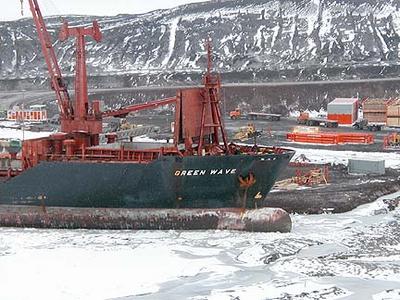
By mid-February, the field season came to a swift end. The Green Wave had docked at McMurdo, and next year's supplies were being unloaded from the ship. This year's trash from McMurdo was also being loaded for the long voyage to the U.S., where it will be disposed or recycled. This marks the traditional end of a "field season" in McMurdo, and we were all anxious to see our names on a flight manifest (the list of people scheduled to be on an airplane). As much as we would miss McMurdo, we missed our friends and family more and wanted to get home! I am now back in Albany, NY, analyzing the results of the long field season. Shortly, I will fly to Geneva, Switzerland, and work with Dr. Pawlowski on the evolution of the Explorers Cove foraminifera. Our two labs have discovered some exciting aspects of the molecular biology of Foraminifera that challenge traditional views of how these important organisms evolved. Such questions have plagued microbiologists and paleontologists for over a century, with no clear resolution in the debate. New methods in molecular biology, and Dr. Pawlowski's clever use of these methods, have allowed us to reexamine these questions, using the unique and abundant foraminifera from Explorers Cove as experimental material. We hope to be reporting some exciting new findings very soon! When first slipping on the Antarctic ice in 1984, I would never have dreamed that one day our studies would help answer important questions asked by some pretty famous scientists over the last 150 years. This is perhaps the most remarkable thing about science -- you never know where the next discovery will come from, or who will make it, or how long it will take for the truth to emerge. I can only hope that our results will help spawn the next generation of scientists to make bigger and better discoveries:) Your friend, Dr. Bowser
Contact the TEA in the field at
.
If you cannot connect through your browser, copy the
TEA's e-mail address in the "To:" line of
your favorite e-mail package.
|
